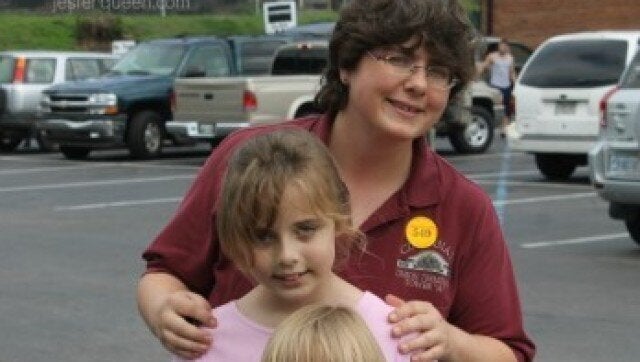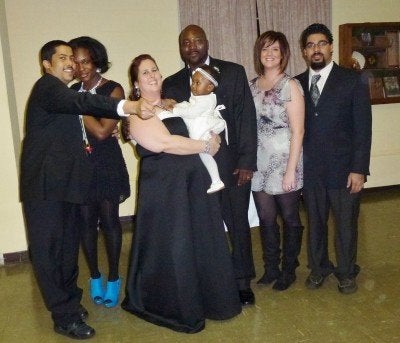
This is the second post of "30 Adoption Portraits in 30 Days," a series designed to give a voice to people with widely varying experiences, including birthparents, adoptees, adoptive parents, foster parents, waiting adoptive parents and others touched by adoption.
Why Do I Have To Be Adopted?Written by Jessie Bishop Powell for Portrait of an Adoption
My only parents are the ones I was born to. My only children are my biological progeny. But adoption surrounds my family, starting with my grandfather and ending with my niece.
Let me explain.
My dad’s father’s biological mother was 12 years old when she got pregnant, 13 when she gave birth. That’s young even by today’s teen mom standards. And it was 1915, so today’s standards weren’t in place. Lucy was probably lucky not to get whisked away to some home. She lived with her father and stepmother following her own mother’s death. Indeed, her father and stepmother had two toddler boys themselves.
When Lucy gave birth, my great-great-grandfather Nally wrote to his oldest daughter, Esther, Lucy’s older sister. He said, “I’ve got three babies in the house, and I just can’t raise all of them and keep farming. You can have your pick.”
Esther wrote back, “I’m coming. I’ll probably arrive before this letter.”
Rather than take away one of her brothers from a mother who most likely wanted them very much, Esther chose her nephew to raise as her own. She and her husband later had a biological daughter named Ramona, and both children were brought up in ignorance of the adoption.
Adoption was shameful back then. Terminology like “real mother” was de rigueur. Women who couldn’t have their “own” children were lesser, and the only reason a fertile woman wouldn’t raise her “own” child was her own inadequacy. And if she was pregnant “out of wedlock” (another popular phrase), then it was clearly all her fault. Never mind if she was only twelve. She should have kept her legs together.
Intra-family adoptions didn’t carry all the stigmas of outside adoption, but announcing that their new son was actually Esther’s nephew would have drawn unwanted attention to my great-grandparents. They also were probably aware that once their biological daughter was born, plenty of people would believe their son was not really their son at all. To shield both their children, they kept the whole thing secret.
But consider Esther’s response to her father. “I’m coming. I’ll probably arrive before this letter.” Can you not feel the urgency in those two sentences? Like she thinks something will happen before she can reach her endangered child. As if she scrawled the words racing out the door to the train station. I feel certain she was always coming for my grandfather rather than either of the other babies in the house. That the moment she read her own father’s letter, Esther knew her young sister had just borne her a son.
Then, when he was about eight or ten, my grandfather found out.
He was alone in the house. He doesn’t remember where his Dad was. Probably down in the field, as they were farmers. Mother Powell, Esther, was downtown at the bank, and she called home. The family had a safe-deposit box of sorts in the drawer of a sewing table, and she needed an account number from one of the papers in the drawer. She said, “George, go find that for me while I hold the line.” So my grandfather went and got the drawer, brought it back beside the telephone, and fished around until he found the account number.
He also found his adoption papers.
Suddenly, mean old Aunt Lucy was actually his birthmother, his sister was really his cousin, and his whole world was a little different. Not terribly different, I don’t suppose, because until his unexpected discovery, he never had an inkling he wasn’t biologically descended from the people who raised him. Also because he can’t remember how Mother Powell answered when he told her what he’d found. He says, “She probably said ‘oh shit.’”
A few years after that, Lucy had another child, a daughter who she kept and raised. And my grandfather grew up wondering if Joan ever knew she had a big brother. When Lucy died, Joan wrote my grandfather a carefully worded letter. He sent her a less carefully worded response: “We are more closely related than you probably ever realized.”
Joan replied, “I used to get so mad at cousin Ramona growing up. Ramona would go on and on about ‘my big brother this’ and ‘my big brother that’, and I’d just want to punch her, because I was thinking no, he’s my big brother.”
So she did know. She knew all along, and both of them grew up unable to talk about being siblings as well as cousins, because adoption was a dirty secret to be kept hidden whenever possible.
Ramona died some years ago, so my grandfather lost one sister. But Joan, twelve years his junior at 83 or 84 is still alive and kicking. They keep in touch and exchange birthday and holiday greetings. Not long after they first formally established contact as sister and brother, Grandpa asked, “Did you ever know who my Dad was?”
Joan said, “I never even knew who my Dad was.” Lucy took those names to the grave.
My grandfather is 96 years old right now. He’s fought off a bout of prostate cancer, wears a pacemaker to control arrhythmia, and wants his doctor to figure out what’s going on with the poor circulation in his legs. Everything about his adoption was shrouded in secrecy, and there are answers he will never get.
Next: "In contrast, everything about my niece Kaylee’s adoption is painfully visible."
In contrast, everything about my niece Kaylee’s adoption is painfully visible. My younger sister, my niece’s mother, had a hard time. In many ways, she made that hard time for herself. Amy was 21 and a complete wreck when she got pregnant. She and Jason got married when they got pregnant, but the marriage didn’t last until Kaylee’s second birthday. Amy was too caught up in her own mental illness and addictions (drug and alcohol) to be much of a mother to my niece. Jason never completely left the picture, but he wasn’t in any better shape than my sister to raise a child.
Around the time that Kaylee was 3, my mother had to make a hard decision. Which one could she save? Her daughter or her daughter’s daughter? She believed it was the latter. She was right.
Thus began a protracted custody battle that ended suddenly with Amy’s death in 2008. I’m not going to talk about what happened here, because I’m using real names, and if my niece someday stumbles over this, I want her to come and ask, rather than finding out how her mother died on a webpage.
Kaylee knows that her mother died, but not the circumstances. When it happened, she asked, “So I don’t have a Mom anymore?” But she didn’t cry for the loss, because she bottles up her emotions and because she hadn’t seen my sister for roughly a year by that point. Jason is still out there. And he still sees Kaylee from time to time. She also still has contact with her paternal grandmother.
The adoption is completely open, and nobody has even changed their terminology. My Mom is still Kaylee’s grandmother, even though she is also her mother now, as well. Kaylee also knows there are things we haven’t told her yet. Things she deserves to know and will know as she gets older. But not yet. Right now, she’s 8, and she’s already having to grow up too fast. When the adoption was finalized, she wanted to know, “Why do I have to be adopted?”.
And not two whole days after my niece became my sister, my maternal grandfather (not the adopted one I was talking about earlier) went into his final decline before dying. So that Mom could care for him, Kaylee had to come spend the summer with my family, where, as deeply as I love her, I am not her mother. I am her aunt. Or sister. As close as she is to my children, they are not her siblings. They are her cousins. Or possibly her niece and nephew.
Depending on how you look at it.
Because despite the fact that everything about Kaylee’s adoption is a known factor, it has created so many uncertainties. My parents are divorced. So does that mean my Dad is still just her grandfather? Or is he also now her father? Except she already has a father in Jason, even if he is a largely absent figure with no legal claims. It’s not like my Dad has any legal claim either, but he still takes Kay to the circus and comes to see her and be her grandparent.
Do you see how biology still shapes Kaylee’s familial connections? Like my grandfather’s, this is an intra-family adoption. But like many modern adoptions, it’s an open-ended equation, where family bonds twist like M.C. Escher paintings and people find themselves connected in the most unexpected ways.
Kaylee has come to terms with her status, and I hope she can someday celebrate it. Mom takes her out for a special meal every year on the adoption anniversary. And Kaylee understands the situation with more clarity every year.
Still. None of us can give her a straightforward answer to the question, “Why do I have to be adopted?” It’s something she’ll have to discover for herself. And even then, what she finds is likely to raise as many questions as it lays to rest.
Portrait of an Adoption is hosted by Carrie Goldman, author of Bullied: What Every Parent, Teacher, and Kid Needs to Know About Ending the Cycle of Fear. If you have a story you would like to submit as a candidate for next year's series, please email it to her at portraitofanadoption@gmail.com.
Find the Portrait of an Adoption community on Facebook. Follow Carrie Goldman on Twitter.
